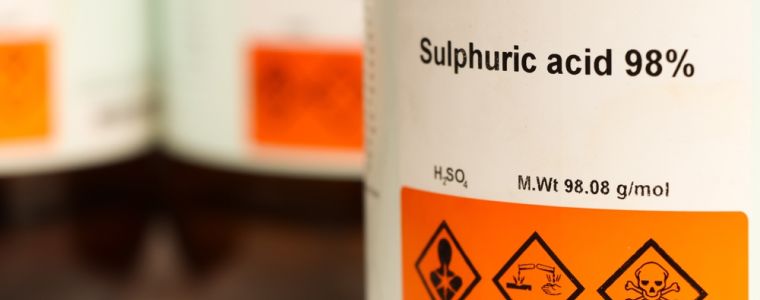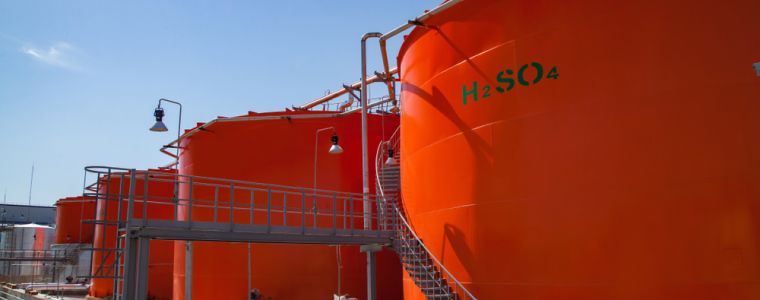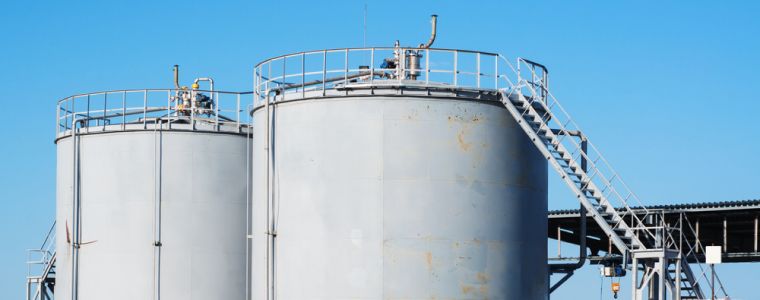Sulphuric Acid (H2SO4) Storage Tanks

Sulphuric Acid (H2SO4) is the most widely used mineral acid in the world, and possibly one of the most important and strategic raw materials.
Sulphuric Acid pH

Sulphuric acid pH is a critical aspect to understand in various industrial and chemical processes. Sulfuric acid is an extremely strong acid, typically classified as a strong mineral acid. In its concentrated form, it has a pH level that can be as low as 1, indicating a highly acidic nature. As sulfuric acid is diluted, its pH level increases, but even in dilute solutions, it can remain highly acidic.
The pH of sulfuric acid plays a significant role in its chemical reactions and applications. In industrial settings, it is often used in processes such as metal etching, fertiliser production, and petroleum refining. Understanding and controlling sulphuric acid pH is crucial for ensuring the efficiency and safety of these processes.
Moreover, the sulfuric acid pH within solutions can also impact environmental considerations, particularly in terms of waste disposal and treatment. Proper management of acidic solutions, including monitoring and adjusting pH levels as needed, is essential to prevent environmental contamination and ensure regulatory compliance.
Sulphuric Acid Risk Assessment

The production, transport and usage of sulphuric acid is extremely hazardous and demands enhanced measures of precaution because the consequences of accidents can be catastrophic. Producers and users of this highly corrosive chemical must take appropriate steps for transport and storage to mitigate the potential risks. The corrosivity of sulphuric acid varies significantly under different concentrations and metallic contamination.
Sulphuric acid is oxidising when concentrated but is reducing at low and ‘intermediate’ concentrations. Commercially concentrated acid is around 96% (specific gravity = 1.84.)
In general, bulk sulphuric acid at 88%- 99.5% concentrations can be stored and transported using carbon steel if fluid velocity does not exceed 0.61 meters per second. 316L can be used to make transfer pipes when the velocity limit is exceeded, it is, however, not recommended for H2SO4 at concentrations lower than 85%.
Without effective measures to prevent atmosphere leaking into the storage tank, problems start to arise as concentrated sulphuric acid absorbs moisture in the air until its concentration becomes as low as 45%.
Conducting a comprehensive sulphuric acid risk assessment is crucial to ensure the safety of individuals and the environment. The following factors should be considered:
1. Chemical Properties: Begin by understanding the chemical properties of sulfuric acid, including its corrosive nature, toxicity, and reactivity with other substances.
2. Hazard Identification: Identify all potential sources of exposure to sulfuric acid in your facility, including storage tanks, handling areas, and transfer equipment.
3. Exposure Routes: Determine the primary routes of exposure, such as inhalation, ingestion, or skin contact, and assess the likelihood and severity of exposure through each route.
4. Risk Factors: Consider factors that may increase the risk of exposure, such as the volume of sulfuric acid stored, the frequency of handling, and the presence of incompatible materials nearby.
5. Safety Measures: Implement appropriate safety measures to control and mitigate risks, including engineering controls (such as ventilation systems and secondary containment), administrative controls (such as standard operating procedures and training), and personal protective equipment (such as gloves, goggles, and respiratory protection).
6. Emergency Response: Develop and implement an emergency response plan to address potential incidents involving sulfuric acid, including spill containment, evacuation procedures, and medical treatment protocols.
7. Regulatory Compliance: Ensure that your sulphuric acid risk assessment and safety measures comply with relevant regulations and guidelines for handling and storing sulfuric acid.
8. Monitoring and Review: Regularly monitor and review your sulphuric acid risk assessment and safety measures to identify any changes in conditions or procedures that may affect the risk of exposure and adjust your controls accordingly.
By conducting a thorough sulphuric acid risk assessment and implementing appropriate safety measures, you can help minimise the risks associated with sulfuric acid.
Selecting Sulphuric Acid Storage Tanks

Selecting the appropriate tank for storing sulfuric acid is critical to ensure safety and prevent environmental hazards. Here are some factors to consider when choosing a suitable tank:
Corrosion Resistance: Sulfuric acid is highly corrosive, so the tank material must be resistant to corrosion.
- Stainless steel, especially 316L or 304L, is durable and corrosion-resistant, offering a long lifespan with minimal maintenance.
- Fiberglass reinforced plastic (FRP) is affordable and non-corrosive, though it can deteriorate over time with exposure to high heat and acid concentrations.
- Lead or brick-lined steel tanks are more economical but require monitoring for lining breakdown.
- Speciality alloys nickel alloys like Hastelloy® are extremely corrosion-resistant but can cost more.
- Concrete tanks erode slowly over time and need frequent inspections and repairs.
Overall, stainless steel and FRP offer the best combination of durability, lifespan, and cost-effectiveness for sulfuric acid storage.
Chemical Compatibility: Ensure that the tank material is chemically compatible with sulfuric acid to prevent degradation or reactions that could compromise the integrity of the tank.
Strength and Durability: The tank should be strong and durable enough to withstand the weight of the sulfuric acid and any external factors, such as temperature fluctuations or physical impacts.
Design and Construction: Consider factors such as tank design, thickness, and construction to ensure that the tank is suitable for the intended storage conditions and complies with relevant regulations and standards.
Ventilation: Proper ventilation is essential to prevent the buildup of hazardous fumes or pressure inside the tank, which could pose safety risks.
Regulatory Compliance: Ensure that the chosen tank meets all applicable regulatory requirements for storing sulfuric acid, including those related to material compatibility, design standards, and safety features.
By carefully considering these factors and selecting a tank that meets the specific requirements for storing sulfuric acid, individuals and organisations can ensure safe and compliant storage practices.
How to Determine the Correct Storage Tank Size

Determining the correct tank size for storing sulfuric acid is essential for efficient and cost-effective storage. Several factors should be considered to ensure the tank meets your needs effectively:
1. Current and Future Volume: Estimate your current and future sulfuric acid usage to choose a tank size that accommodates your needs for at least 3-5 years.
2. Filling Frequency: Consider how often you want to refill the tank and choose a size that aligns with your desired refill frequency.
3. Secondary Containment Requirements: Understand regulations regarding secondary containment and select a tank size that fits within containment guidelines.
4. Tank Costs: Compare the upfront costs of different-sized tanks to your budget and choose a size that offers the best balance of cost and functionality.
By evaluating these factors, you can select a sulfuric acid storage tank size that efficiently meets your needs while complying with Sulphuric acid risk assessment and budget constraints.
Alloy Selection
The response of most stainless steel types is that in general they are resistant at either low or high concentrations but are attacked at intermediate concentrations. Moreover, in the presence of oxygen the corrosion rate of stainless steels can drastically increase.
Care is needed with very concentrated, (98-100%), acid at higher temperatures as any slight changes to the conditions, for example, the high concentration falling by dilution or increases in velocity or reductions in oxidising conditions, can affect the corrosion resistance anticipated.
Also, the presence of chlorides in sulphuric acid can be an additional hazard. Hydrochloric acid, (HCl), can be liberated from sodium chloride by sulphuric acid, depending on the temperature, making the mixture more aggressive.
Alloy 316L. Is a chromium-nickel-molybdenum austenitic stainless steel. Generally resistant to strong sulphuric acid at ambient temperature and resists erosion-corrosion. Corrosion resistance is good in the absence of abrasive particles.
Alloy Hastelloy® B-2. A nickel-molybdenum grade alloy widely used up to 70% concentration at boiling temperatures and 99% + concentrations to about 120°C.
Alloy 20. A nickel-iron-chromium grade alloy and a popular choice for its robustness over a wide range of conditions up to about 60°C.
Alloy 825. A nickel-iron-chromium grade alloy with the addition of molybdenum, copper and titanium. Is useful up to about 70% concentration in temperatures from 60°C – 80°C.
AL-6XN®. Super austenitic nickel-chromium-molybdenum-nitrogen grade for storing H2SO4 at lower concentrations up to 70%. Especially chosen over alloy 20 when the level of chloride contamination exceeds 5,000 ppm.
Alloy 904L. A nickel-chromium-Molybdenum grade with the addition of copper. This steel was specifically developed for sulphuric acid use and can be used across the whole concentration range up to 35°C.
Duplex Stainless Steels. Contain a mixed microstructure of austenite and ferrite – usually in a 50/50, but occasionally a 60/40 ratio. They tend to have higher chromium and molybdenum with lower nickel contents than austenitic stainless steel. They are used to store sulphuric acid at mild concentrations strictly limited to temperatures up to 60°C.
Zeron® 100. (S32760). A super duplex stainless steel. At concentrations >90% Zeron 100 exhibits excellent resistance to corrosion and the alloy finds uses in the heat recovery sections of sulphuric acid plants where the 98% acid is around 200°C.
Useful Links:
https://bssa.org.uk/bssa_articles/selection-of-stainless-steels-for-handling-sulphuric-acid-h2so4/ https://nickelinstitute.org/media/4122/alloy-selection-for-service-in-sulphuric-acid-10057.pdf
Choosing the correct alloy for your sulfuric acid storage tanks is essential, as it influences corrosion resistance, longevity, and risk mitigation. Let NeoNickel guide you in selecting the best nickel alloy for your requirements. Reach out to us for technical support, sales enquiries, and more.
————————————————————————————————————————-
Hastelloy® is a registered trademark of Haynes International Inc.
Zeron® is a registered trademark of Rolled Alloys Inc.
AL-6XN® is a registered trademark of Allegheny Ludlum Corporation.
